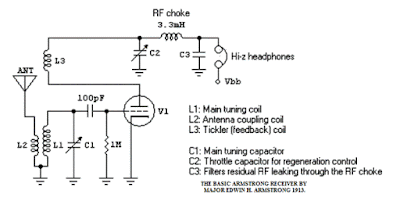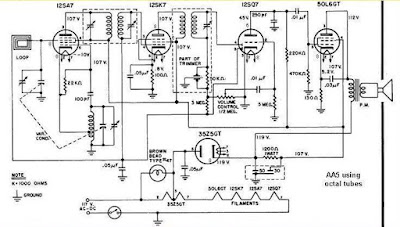3/1/20 Hi tube enthusiasts interested in RF with tubes. A brief: -Edison invented the light bulb. -Fleming of UK imported Edison's bulbs. -Fleming played with a bulb and placed a second element inside. -Using batteries, he discovered electrons moved inside the bulb. Eureka! The DIODE! -Back in the U.S.A., a third element was discovered to control the flow of huge electrons with TINY currents. EUREKA! THE TRIODE. It was originally called the AUDION. So, it is CATHODE,GRID,PLATE. -Electrons moved fast inside the tube, i.e. at high voltage, 45 volts upwards. Armstrong, American, was first to experiment RF in a tube. He used the basic t riode as an RF amplifier. He invented the REGENERATIVE RECEIVER.
Posts
- Get link
- X
- Other Apps
For quite sometime, octal tubes was standard until the minis came out, the 7 pin tubes, then of course the 9 pin tubes. The 6SA7, 6SK7, 6AQ7 and the power amp were replaced by the minis 6BE6,BA6,AV6, an the 50C5. If you have the RCA tube manual, they no longer show the octal version. Now, if we analyze the circuit, we actually do a hybrid and eliminate the power amp and use an IC amp. Secondly, we will not need the pre amp in the AQ6 since the IC amp is sensitive enough. If not, a tranny will boost the signal. /Thirdly, we do not need a tube diode. A 1n34 will work. I have done this. And the best news is that we won't need the recgifier tube as the RF tubes can work on even 12 volts as well as the IC. WHAT IT MEANS WE ONLY NEED THE FIRST 2 TUBES! If you have the octals, nice and nostalgic. If none the BE6 and the BA6 will do. 6 olt or 12 volt filament will be ok. If we need to raise the B+, we can do a voltage doubler. A 1 amp main traffo will do. 12 V will have the advantage...
- Get link
- X
- Other Apps
The problem with the Regen radio was that it was fidgety and lacked selectivity. The next type of tube radio then was called the TRF for Tuned radio frequency. The idea was a series of amplifiers each with a tuning coil. There were just too many tuners! But it can fine tune to a station. It was still figedty to the taste and something has to be developed to make a USER FRIENDLY radio. Armstgrong went back to the drawing board. He knew the principle that frequencies can be MIXED. His goal was go reduce the number of tuning condensers. Finally, he invented the SUPERHETERODYNE radio when a local oscillator is mixed with the incoming signal. The tuning capacitors of the antenna coil and the oscillator coil were ganged. The differential frequency was kept constant at 455 Khz. The next amplifier as tightly tuned to 455 Khz. Till today, this principle is still used. Superhets spread all over the world and in the U.S.A., the most common was a five tube set up. It was called the All American...
- Get link
- X
- Other Apps
There are so many one tube radio in the website but they use old tubes like 1T4. I intend to experiment with a commonly found tube like the 12au, ax,at twin triode to make a simple rfegen MW radio using the ferrite bar coil of an AM radio and the PVC varicap commonly available. Then put an IC audio amp. It should be possible using 12 volts DC. Perhaps a kit.
Regen circuit
- Get link
- X
- Other Apps

Description. In 1913 Major Edwin H. Armstrong patented a design for the Regenarative Receiver that uses the principle of positive feed-back in amplifiers to demodulate AM, CW, SSB, and FM. Mr. Armstrong's circuit is shown and used the new vacuum tube of the time. The Regenerative receiver has since become the most popular basic receiver for Amateur Radio Operators and Electronics experimenters worldwide. The principle of operation is simple. Positive RF feedback is used to increase the RF gain of the amplifier up to and beyond self-oscillation. With no input RF signal the internal noise peaks and a small bias voltage combine to produce a stable but self-limiting oscillator, except right at the peak of oscillation very high gain is produced and the detector becomes very sensitive to small input RF signals, like those associated with SSB and CW. AM is demodulated just below the point of oscillation, but SSB and CW are demodulated when an RF signal combines with the heterodyne sign...
